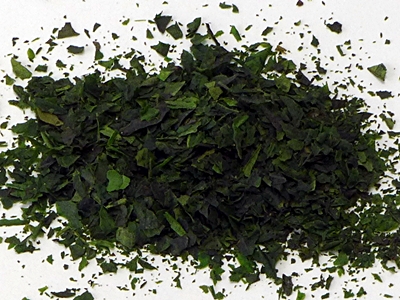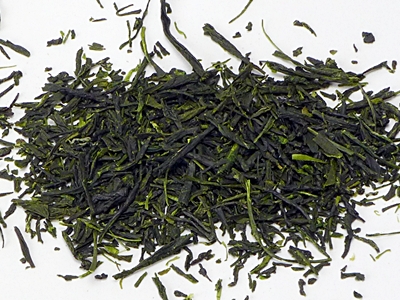From GYOKURO to MATCHA
From GYOKURO to MATCHA
Tencha, the raw material used to make matcha

Tencha: The Raw Leaf of Traditional Japanese Matcha
Tencha Production Process
[Shading Cultivation] (Covered Cultivation)
Approximately 20 days before harvest, the tea plants are shaded to reduce bitterness and enhance umami flavor components, especially amino acids such as theanine. Traditional straw coverings or modern black shading nets are used.
[Steaming Process]
Immediately after harvesting, the leaves are steamed to prevent oxidation?this step is the same as in sencha production.
[Drying]
Unlike sencha or gyokuro, the leaves are not rolled but dried as they are. This results in thin, flat leaves.
[Removing Stems and Veins] (Finishing)
Before grinding into powder using a stone mill, stems and leaf veins are removed, leaving only the soft leaf parts.
Characteristics of Tencha
Appearance: Thin, flat leaves with a vibrant green color.
Taste: Mild bitterness and rich umami flavor.
Aroma: A distinctive "nori-like" fragrance (known as "tencha aroma").
Uses: Primarily ground into matcha powder using a stone mill, for tea ceremony use or culinary purposes.
Cultural Significance of Tencha
As the precursor of matcha used in the Japanese tea ceremony, tencha is deeply rooted in Japanese culture and the spirit of chanoyu.
Although often confused with matcha overseas due to its rarity, tencha is the raw tea leaf stage before it becomes matcha.
Gyokuro", Japan’s Finest Green Tea
 Gyokuro is considered the highest-grade tea among Japanese green teas.
Gyokuro is considered the highest-grade tea among Japanese green teas.It features a distinctive umami flavor, mellow sweetness, and smooth texture, and is cultivated using a special method known as “covered cultivation” (Oishita-cha).
[Gyokuro Cultivation Method] (Shading Cultivation)
About 20 days after the new buds emerge, the tea bushes are shaded using a special netting.
By blocking sunlight, photosynthesis is suppressed, reducing the bitter catechins while increasing umami compounds like theanine.
There are two shading methods: "Hon-gou" (traditional straw covering) and "Kani-gou" (modern black netting).
[Gyokuro Production Process]
Tea leaves are picked either by hand or machine.
Steaming Process (to prevent oxidation)
Rolling Process (to shape the leaves)
Drying Process
The leaves are gently dried, roasted, and refined to enhance their aroma and flavor.
They take on a thin, needle-like shape with a rich, deep green color.
Flavor and Aroma Characteristics of Gyokuro
Taste: A rich, mellow flavor with a viscous texture, strong sweetness, and very little bitterness.
Aroma: A refined, seaweed-like fragrance known as "covered aroma" (Ooika).
Umami: High in amino acids, especially theanine, giving it a much stronger umami profile than sencha.
Both Gyokuro and Tencha Are Premium Japanese Teas
Both Gyokuro and Tencha Are Premium Japanese Green Teas, but They Differ in Their Final Processing Stages.[Similarities]
Both are cultivated using the shading method (known as Oishita cultivation), in which young tea leaves are grown while shielded from direct sunlight.
They contain high levels of umami compounds such as theanine and have a mild bitterness.
Both are considered luxury-grade teas in Japan.
[Differences]
Processing: Tencha is not rolled during production; Gyokuro is rolled.
Leaf shape: Tencha leaves are flat and spread out; Gyokuro leaves are needle-like and rolled into thin sticks.
[Characteristics of Tencha]
Shading period: About 20 days, similar to Gyokuro.
Leaves are not rolled during processing and are dried as-is.
Mainly used as the raw material for matcha.
Leaves remain flat and broad.
When ground into powder, Tencha becomes matcha, which is known for its rich flavor and vibrant green color.
[Characteristics of Gyokuro]
Shading period: Also around 20 days.
Leaves are rolled during processing to shape them.
Typically brewed in a teapot and enjoyed as loose-leaf tea.
Leaves are thin, needle-shaped, and tightly rolled.
Flavor is exceptionally smooth with a strong umami taste and a fragrant aroma.
Grinding Gyokuro Like Tencha to Make Matcha
While Gyokuro and Tencha differ in whether the leaves are rolled or not during the final processing stage?which results in different leaf shapes?they are cultivated using the same shading method. Therefore, when finely ground, both can be turned into matcha.The matcha mill I design is specifically engineered to grind Tencha's thin, flat leaves smoothly and without strain.
When grinding Tencha, simply place the desired amount of leaves into the hole of the upper millstone and rotate the top stone continuously. This results in fine matcha powder.
However, when using the same method with Gyokuro, the amount of tea leaves entering the mill is often too much, resulting in a coarse grind.
To solve this, when grinding Gyokuro, it’s important to reduce the amount of tea leaves supplied into the millstone.
Instead of placing all the tea into the hole at once, place the leaves on the dish area of the upper stone. Then, using your left hand, add a small amount at a time, rotate the upper stone a few times, and repeat this process.
While grinding, pay close attention to the texture of the powder, the feel in your right hand turning the mill, and the sound of the leaves being ground. This will help you judge the right rhythm and consistency for producing fine matcha from Gyokuro.
How to Use a Matcha Mill to Grind Gyokuro into Matcha
If you grind Gyokuro using the same method as Tencha, the result will be coarse.
It is possible to make matcha from Gyokuro.
Using Gyokuro, which is more readily available than Tencha, to make matcha is an effective alternative.This method is especially recommended for those outside Japan, where obtaining Tencha can be quite difficult.


